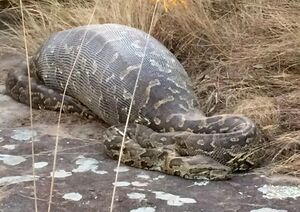Shilowa (historical snake)
Shilowa (c. 1692-1713) was a large historical snake and favored pet of Mwenekonji Mfumi I xa Kitambala, founding Mwene of the Kitambala dynasty. Contemporary historical accounts describe the creature as a Central Malaioan rock python of particularly enormous size. Mfumu I cherished Shilowa so greatly that when she died to the champion Burheni in the 1713 Tournament of Labors, she was posthumously declared an incarnation of Yayingi, a water spirit who guards heavenly Uhlanga. Her remains were cast in platinum and fashioned into an idol at the center of a shrine dedicated to the spirit.
Discovery
Shilowa was discovered in 1695 near the mouth of Lake M’buxila by Mfumu and a small retinue of followers during the Konji-Xuunda War. The Mwene-a-yeyeni of Xuunda, Fwaninge VI, an important vassal of Konji, had declared independence the year previously, expelling Konjilese representatives from the royal court and driving their forces from the region at the Battle of N’Xaanba. Konjilese forces would steadily push into Xuunda early that year, causing Fwaninge and her host to retreat to Nkenukala, a town built into the hillside and surrounded by a tributary of the Nakwenda river. Mfumu initially intended to take his forces around the hilly terrain, which would have taken several months and allowed the Xuundazi time to dig in.
According to contemporary accounts, Mfumu was thrown from his horse while passing through scrub bush. A “serpent the length of four men, mottled like the rays of the sun, enveloped the whole of the mwene’s horse”. Mfumu is said to have halted his men from harming the creature, opting instead to capture it alive. That evening, when the snake was brought to Mfumu’s tent, he is said to have “received powerful visions of the simbi Yayingi, who in exchange for being offered sacrifice and shelter by Mfumu would calm the Nakwenda’s currents and allow his men to travel it upstream.”
The following night, Mfumu and a band of elite warriors would travel up a small tributary of the Nakwenda which, due to unusually heavy rains, had yet to dry up. This allowed the group to slip into the town and scale the port-adjacent fort’s wall, where they quickly overwhelmed the guards, killed the royal family and beheaded Fwaninge herself. Xuunda would quickly capitulate the following year in exchange for Konji’s support of Fwaninge’s sister, Ditu XVII’s claim to the throne. In the aftermath of the war, which firmly cemented the Kitambala dynasty’s rule over the Konji Kingdom, the yellow python would be taken up as the symbol of the royal house of Kitamba.
Royal court and Tournament of Labors
The snake, which was named Shilowa in an elaborate religious ceremony, became a staple fixture of Mfumu I’s court. It dwelt in a specially made habitat directly opposite the Mwenekonji’s throne, where he granted it the title of Mwene-a-mbona, or Lord of pythons, and allegedly even a seat on the council of royal advisors. The latter however is believed by historians to have been a slight against the council’s authority rather than a conscious effort to elevate her status. In 1709, Shilowa was used in the execution of the Mwene Bampa (treasurer) Malomba a Nzuni, in which he was deliberately bound and smeared with offal in order to be fed to the snake.
In 1713, Mfumu I held the Tournament of Labors, in which a large group of prisoners were selected to compete in a selection of challenges. Shilowa was used in the fifth and final challenge, in which the final competitor, Burheni, engaged her in a contest of grappling. The two are said to have fought for the whole of the day, Shilowa succumbing eventually to exhaustion and dying shortly thereafter. Other accounts of the bout hold that she was killed by Burheni by “having her head twisted so as to break her neck”.
Regardless, an ostentatious and elaborate funeral was held for Shilowa, in which her embalmed remains were paraded atop the ceremonial pillows traditionally used to carry deceased Mwenekonjis. The Mwene-a-nganga (Lord-of-priests) commissioned the building of a shrine to Yayingi on the site where Shilowa was discovered, where her bones were encased in a large platinum idol of her likeness. This created a tradition among later Mwenekonjis of adopting pythons as living totems of good luck and trade, the latter of which rivers were typically associated with.
